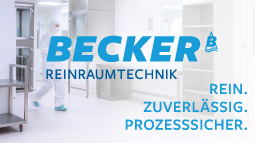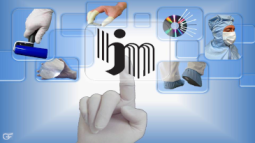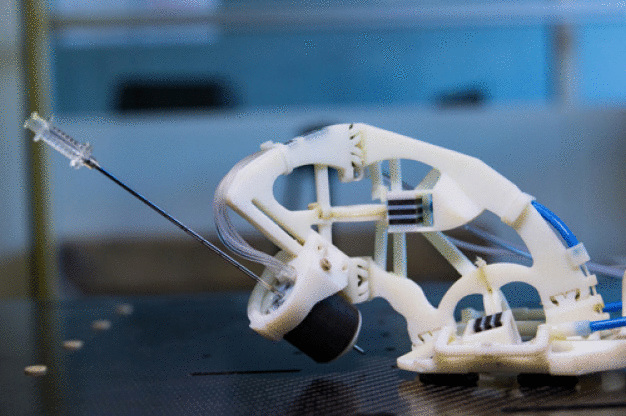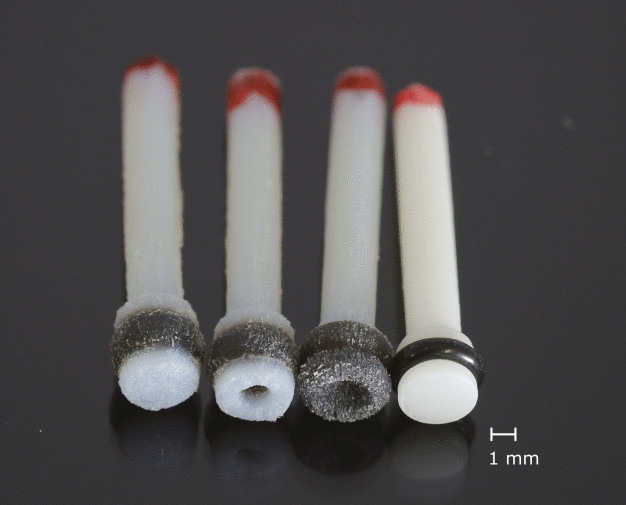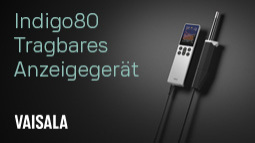- R+D & Community of Interest
3D-printed medical robots
Five international research teams are developing a robot for cancer treatments of the future. Although it comprises dozens of components, joints and parts with varied material characteristics, this robot can be printed using a 3D-printer in a single-step process.
All that is required is a single click of a button – the 3D-printer takes care of the rest. As is the case with an ink jet printer, fluid is sprayed onto the surface. However, instead of different colors, this PolyJet printer uses plastic: the jets can apply two different polymer solutions, either individually or mixed, with pinpoint accuracy. UV light hardens the plastic before the next layer is applied to produce a medical robot, layer by layer. When fully developed, the robot will assist doctors in taking biopsies and in tumor thermotherapy.
“The positioning of a needle or probe in a minimal invasive procedure is absolutely crucial, because at best the doctor can be guided by computer tomography or MRT imaging and that means working with the patient lying in a narrow tube. This more or less limits the doctor’s freedom of movement”, explains Marius Siegfarth of the Fraunhofer IPA project group for Automation in Medicine and Biotechnology (PAMB) at the Medical Faculty Mannheim at Heidelberg University.
The robot is being developed by Siegfarth’s team under the SPIRITS project in conjunction with other research groups from Germany, France and Switzerland. The robot is small and light enough to be inserted in the scanner tube with the patient. It is controlled hydraulically from outside – so that doctors can be a few meters away and may even be in another room, where they are protected from CT imaging radiation hazard. The acronym SPIRITS stands for Smart Printed Interactive Robots for Interventional Therapy and Surgery.
“The challenge presented by this project was to develop a design that could be generated in a single stage by PolyJet printer, but that at the same time comprised fully functional components, for example, rotary joints with hydraulic actuators and a drive mechanism to move the needle. All these components have different material characteristics”, Siegfarth adds.
The PolyJet is already printing out the first prototypes at the Institut national des sciences appliquées de Strasbourg, INSA, where the SPIRITS project is being coordinated. These prototypes have lever arms linked by rotary joints that can rotate the needle in any direction around the point of entry. The movement is provided by a hydraulic drive system developed by PAMB researchers using tiny tubes with diameters of just 4 millimeters, seals and pistons. What is particularly special here is that the design of the piston produced by 3D print technology exerts hydraulic pressure on the seal and thereby enhances its effectiveness.
Initial trials show that the hydraulic drive generated by 3D printer works. In the coming months, further elements will be integrated in the prototype: for example, a smart needle equipped with a force sensor, a development by the École polytechnique fédérale de Lausanne, EPFL, while the mechanism driving the needle was developed by INSA researchers. Another feature is the “haptic feedback”, which converts the results measured by the force sensor into resistance that the doctor will be able to feel when directing the needle through softer or harder tissue. The feedback function was developed by researchers at the Furtwangen Technical College, while the University of Applied Sciences of Northwest Switzerland (FHNW) is currently producing printable, non-magnetizable metal components for the next generation of prototypes.
The first fully printed medical robot will be tested on dummies as early as before the end of 2019.
With a total budget comprising EUR 1.67 million, SPIRITS is being co-financed by INTERREG V Oberrhein, while the European Regional Development Fund (ERDF) has contributed an additional EUR 436,201. The project is receiving further support from regional and cantonal partners as part of the “Offensive Sciences” initiative, which finances state-of-the-art research projects on a cross-border basis. Consequently, the project has also received financial backing from Großregion Ost (macro region East), the German states of Baden-Württemberg and Rhineland-Palatinate, the Swiss Confederation, the Cantons of Aargau, Basel-City and Basel-Country.
![]()
Fraunhofer-Institut für Produktionstechnik und Automatisierung IPA
Nobelstraße 12
70569 Stuttgart
Germany
Phone: +49 711 970 1667
email: joerg-dieter.walz@ipa.fraunhofer.de
Internet: http://www.ipa.fraunhofer.de
